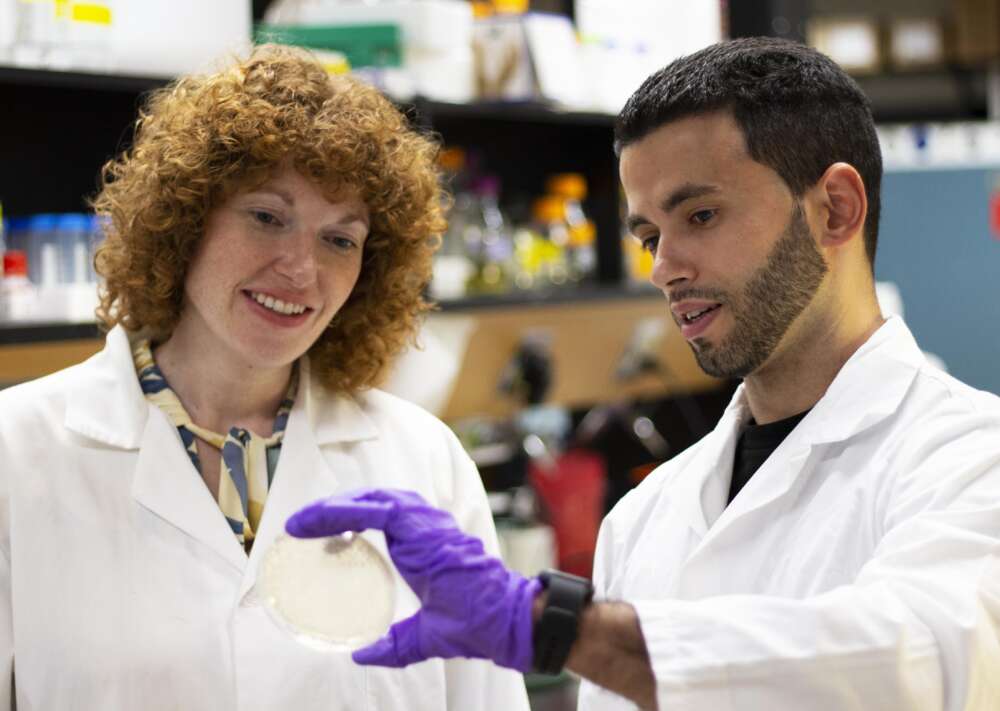Snails may be slow, but a chemical made by the creatures may be quick to fight a fungal pathogen that kills tens of thousands of people every year, according to University of Guelph researchers.
Compounds extracted from three snail species prevented a deadly fungus, Cryptococcus neoformans, from spreading and evading the human immune system in a study led by Davier Gutierrez-Gongora, a PhD student in U of G’s Department of Molecular and Cellular Biology (MCB) within the College of Biological Science and MCB professor Dr. Jennifer Geddes-McAlister.
Recently published in the journal Scientific Reports, the study was co-authored by master of biotechnology student Fouad Raouf-Alkadhimi along with Dr. Ryan Prosser, a professor in the School of Environmental Sciences (SES) within the Ontario Agricultural College.
Although antifungal medications for destroying the pathogen or slowing its growth are widely used in medicine, C. neoformans can develop resistance to them, especially during long courses of treatment. Individuals with underlying conditions, such as HIV/AIDS that compromise their immune system are particularly at risk.
Snail extract compounds block mechanisms fungi use to spread

Since snails can’t easily leave their environments, they have instead developed chemical defences against pathogens like fungi.
Instead of attacking the fungus itself, the compounds in snail extracts block some of the mechanisms the fungus uses to spread and defend itself from the host. This way, the pathogen can be disarmed without developing resistance, allowing even a weakened immune system to clear the infection.
Attacking these mechanisms, called virulence factors, is a growing area of research in response to drug-resistant diseases, but most scientists focus on fighting bacterial infections.
“Only 1.5 per cent of funding for infectious disease research goes to studying fungal pathogens, but they kill over 1.5 million people every year,” said Gutierrez-Gongora. “There’s no balance between the prevalence of fungal pathogens and the availability of antifungals. That’s why we need more strategies to target fungal diseases.”
Gutierrez-Gongora began looking at extracts from marine invertebrates to control bacterial infections during his undergraduate degree at the University of Havana in Cuba. Now working with Geddes-McAlister, he is studying slow-moving invertebrates in Ontario that might have defence mechanisms against fungal pathogens.
“Snails move very little, so they have to be able to protect themselves from pathogens in the environment around them,” said Gutierrez-Gongora. “Unlike humans, they don’t have adaptive immune systems and don’t produce antibodies. Instead, they rely on chemical compounds to defend themselves against viruses, bacteria and fungi. And since the compounds are coming from animal tissue, there’s less of a chance that they’ll be toxic to mammals.”
Compound has agricultural use potential as well
The researchers tested three species of snails found in southwestern Ontario: the introduced grove snail, collected from Howitt Creek in Guelph; the invasive Chinese mystery snail, found in Guelph’s Speed River; and the native ramshorn snail, from a collection in SES.
Extracts from the Chinese mystery snail and grove snail impaired the fungi’s ability to produce virulence factors, while extracts from the ramshorn snail had a fungicidal effect, killing some of the pathogen’s cells.
Gutierrez-Gongora and Geddes-McAlister are now working to identify and isolate the specific compounds in snails that fight against C. neoformans and that may eventually be used to create drugs. The researchers have submitted three invention disclosures for potential medical applications to the University’s Research Innovation Office. They’re also studying similar properties in mussels and slugs.
Beyond those potential medical uses, the compound might help in agriculture and industry. Fungicides are used to protect crops on farms, but growing anti-fungal resistance makes fungal infections difficult to treat in clinical settings.
This study has been funded by the Natural Sciences and Engineering Research Council’s EvoFunPath CREATE program, the Canada Foundation for Innovation, the Ontario Ministry of Colleges and Universities, the Canadian Institutes of Health Research, the University of Guelph and an Ontario Graduate Scholarship.
Contact:
Dr. Jennifer Geddes-McAlister
jgeddesm@uoguelph.ca
